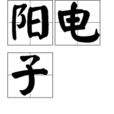基本信息,詞語解釋,2光子轉變,3核聚變,4其他方法,
基本信息
【詞目】陽電子,正電子,反電子,正子
【注音】yáng diàn zǐ ㄧㄤˊ ㄉㄧㄢˋ ㄗㄧˇ
【詞性】名詞
【結構】偏正式合成詞
詞語解釋
[positron;positive electron]正電子。
產生方式
1.正belta衰變
Some times,when a nucleus can become more stable by increasing its neutron-to-proton ratio, it takes a proton and converts it to a neutron. As we all know, the atomic number increase by 1, by the mass number remain the same. And when an particle undergo this kind of Positron Emisson(or you could say Positive Beta Decay), it emits the positron(or we could the positive electron), which got it name from the fact that it carries a positive charge).在一個原子核可以變得更加穩定時,通過增加中子到質子的比例,把一個質子轉變為中子。我們都知道,原子數增加了1,質量數保持相等。當一個粒子經歷了一個正Belta衰變,放射出一個正電子。
2光子轉變
在T=5*10^9K的溫度下光子可以較高程度的反應生成正負電子對,體系熱平衡時正電子數量和光子數量大致相等。
3核聚變
恆星們主要的核反應就會釋放出正電子,比如我們的太陽,其中每時每刻都在發生如下反應:四個質子聚合成1個氦核,同時釋放出兩個電子中微子和兩個正電子。
4其他方法
利用能量高於1兆電子伏的γ射線輻射鉛板、薄金屬箔、氣態媒質等都有可能觀察到正電子的出現。

